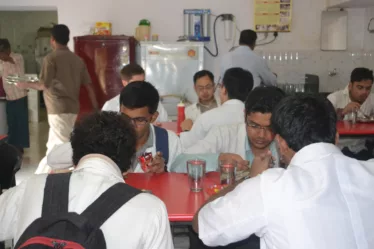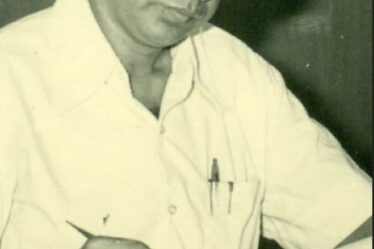He obtained MD (Medicine) but never practised as a physician. He headed the department of Forensic Medicine but never obtained MD in the subject that he led!
Dr. Radheshyam Naik, one of the greatest pillars of the Department of Forensic Medicine, was paradox personified.
On Sunday, 1 April 2018, he died peacefully at home. He let his life ebb away and left this world in his trademark style—quietly and instantly, without any bustle, tumult or agitation.
Born in Bahera, a Village 80 km north of Durg in Chhattisgarh, he was named after Lord Krishna. His parents chose to do so because he was born on Krishna Janmashtami. His father, Shri Man Rakhan Lal, was a zamindar who donated a large chunk of his land to Vinobaji’s bhoodan movement. Dr. Naik went to the Government Medical College, Nagpur and emerged five years later with a MBBS qualification. He went on to obtain MD (Medicine) from his alma mater—spending three years under the tutelage of Dr. JN Berry, the legendary physician and the head of the Department of Medicine. During his post-graduation, he was appointed as a demonstrator in the Robertson Medical School, since renamed as Indira Gandhi Medical College, as a member of faculty. Soon, he moved to Dr. Vaishampayan Memorial Government Medical College, Solapur. Those were the days when medical schools would pick up a faculty from the departments of Anatomy, Pathology, Medicine, and Surgery to run the Department of Forensic Medicine. Dr. Naik didn’t flinch when he was asked to move from Medicine to Forensic Medicine. He accepted the order with nonchalance. No matter how adverse the circumstances turned out to be, he maintained his composure. Que sera sera.
He was destined to pursue a career in Forensic Medicine.
In 1977, destiny brought him to Sevagram. At the behest of Dr. Sushila Nayar, founder director of MGIMS, he joined MGIMS as a professor in the Department of Forensic Medicine. He also served as the warden of the boys’ hostel for over a decade-and-half. He enjoyed a reputation of being a very student-friendly warden—a quiet man, soft-spoken and unobtrusive—who tolerated their mischief and boisterous parties with a characteristic “boys will be boys” attitude.
When he arrived in Sevagram, there was no television. He started running a cine club on campus, where a movie used to be screened, every weekend. The cine club sought to bring some life to the entertainment starved Sevagram.
Along with Dr. AC Mohanty who started MD (Forensic Medicine) at Indira Gandhi Medical College, Nagpur, Dr. SR Naik had the distinction of being a visionary who started post-graduation in Forensic Medicine at MGIMS, Sevagram. He did so in the early eighties, when the major medical schools in Maharashtra couldn’t do so. Dr. SK Singhal, a young and energetic student from the batch of 1976 enrolled himself in the department as his first post-graduate student. During his long stint at MGIMS, he went on to mentor 14 students; each of the students felt that a personal bond existed with him. A low-profile teacher who taught multiple generations of students at MGIMS (from 1975 to 2004 batch) he helped the discipline of medical jurisprudence take roots and grow. He lovingly nurtured the department and streamlined its teaching programme.
Dr. Naik had a penchant for studying a variety of subjects: he tried his hand at Arts, Administration, and Law and earned BA, MA, MBA and LLB degrees. Focusing on Arts and Law helped him become a complete Forensic Physician who later developed a special interest in Toxicology. As one who had no
qualms studying with Dr. SK Singhal, his own postgraduate student, the teacher and the student would go together to attend law classes in the early eighties!
Dr. Naik was aware that unlike other fields of medicine, forensic medicine is one where the doctors never come across a living person. He also knew that Forensic Medicine seldom caught the fancy of medical students. They found his subject dull and uninspiring, and loathed examining the cadaver to learn the cause of death. His efforts ensured that the subject of forensic medicine grew from the days when it was taught as part of pathology, to being a specialty in itself.
Dr. Ashok Mehendale, his student from the class of 1976, recalls, “Forensic Medicine is traditionally perceived as a dry subject, but Dr. Naik knew the art of injecting humour, spicing the tedious topics with humour and enlivening his classes. Students would look forward to attending his classes – held every Tuesday and Saturday because he was an entertainer as well as an educator. He artfully made the topics relatable: he would use scenes from the Bollywood movies—Waqt (1965) and Ittefaq (1969)were his favourite movies—to entertain the class. He also knew how to make dramatic points and make sure students understand why a topic matters and how it impacts them. To the class he was a stress buster—jokes, witty metaphors, humorous similes, puns, sarcasm or a funny story— he would use these time-tested tools to keep his audience relaxed. He was passionate about the licensed 12 bore guns that he owned and would take great pride in showing his proud possession to the students as he explained firearms injuries to them.”
Says Dr. Abhay Kelkar ( MGIMS class of 1987), “I remember him for his impartial attitude towards his own son, Tarun, who was our classmate. No undue favours were ever granted to him. He was a man of few words but with a subtle sense of humour.” Dr Bipin Tirpude enjoyed a 15 year long association with him. He recalls, “ Dr. Naik in his Chhattisgarh slang, would mix English with Hindi to deliver impromptu lectures. He used to have 100 percent attendance in his classes. He was an inspiring teacher and mentor to students and colleagues and was unfailing in his dedication to his students and insatiable in his curiosity to hear alternative points of view. His jokes and one-liners were legendary, and the former students from MGIMS often recall humorous anecdotes that filled his classrooms.
Dr VK Gupta (MGIMS class of 1976) recalls, “ Unlike other teachers, he used to commute from Nagpur. He had two scooters strategically placed at Nagpur and Sevagram, each. Cool in the classroom and well-versed with the subject matter, he was running the forensic department as a solo player, as there was no postgraduate at that time. He never punished any hooligans. He was liberal with attendance and in the examination too. He topped the LLB final in Nagpur University and his protege SK Singhal topped the examination in the first year.”
Dr. Naik retired from Sevagram in 2005. Refusing to hang his boots, he taught for a few years in medical schools in Pokhara in Nepal. He left Nepal nine years ago and chose to spend the last leg of his life in Bahera, his ancestral village in Raipur district in Chhattisgarh. His last years of life were marked with Parkinson’s disease and mild dementia.
Dr. Naik was my neighbour—for several years, we lived in the same building on MGIMS campus. Introvert, unassuming, and self-effacing, Dr. Naik was polite to a fault. I was his physician too. Although he was armed with a MD (Medicine) degree, he made light of his degree and played a perfect patient—listening to the advice carefully and adhering to the treatment to the hilt.
Dr. Naik is survived by his wife, two sons, and a daughter. Tarun (MGIMS Class of 1987) practises surgery at Chandulal Chandrakar Memorial Hospital, Bhilai, Vishal (an engineer) serves at Pune and Harsha (MGIMS batch of 1998) is currently in Manchester, UK.
A day before he died, Dr. Bipin Tirpude, his student and the current chair of the Forensic Medicine at MGIMS, called upon him. Reminding Bipin that he was in the autumn of his life, and life was ebbing away, he took a stroll down memory lane and fondly remembered his MGIMS days. He also expressed a desire to visit Sevagram. Bipin was too happy to fulfil his teacher’s wish and began planning a get-together and a lunch with the department staff. Alas, that was not to be.

